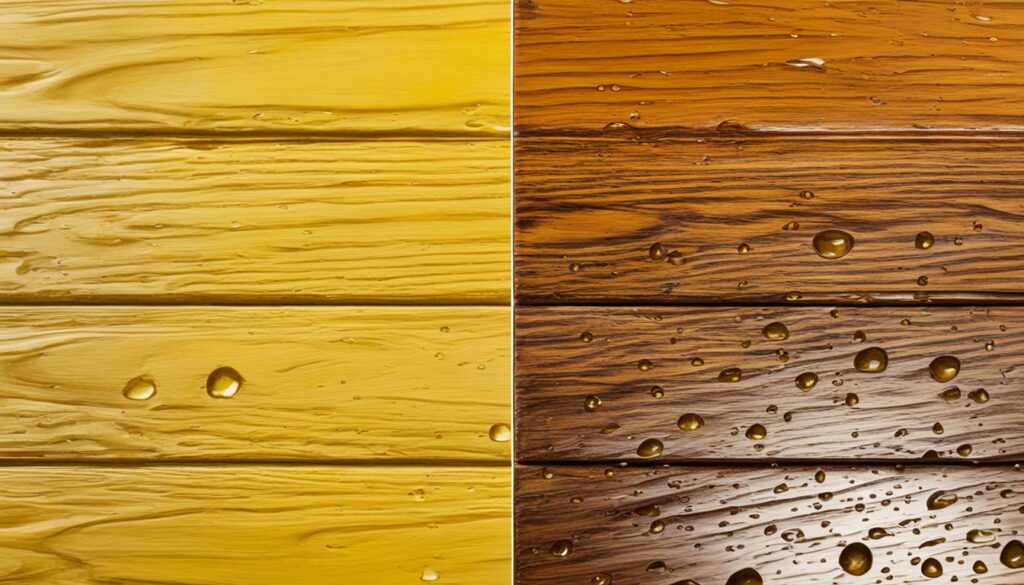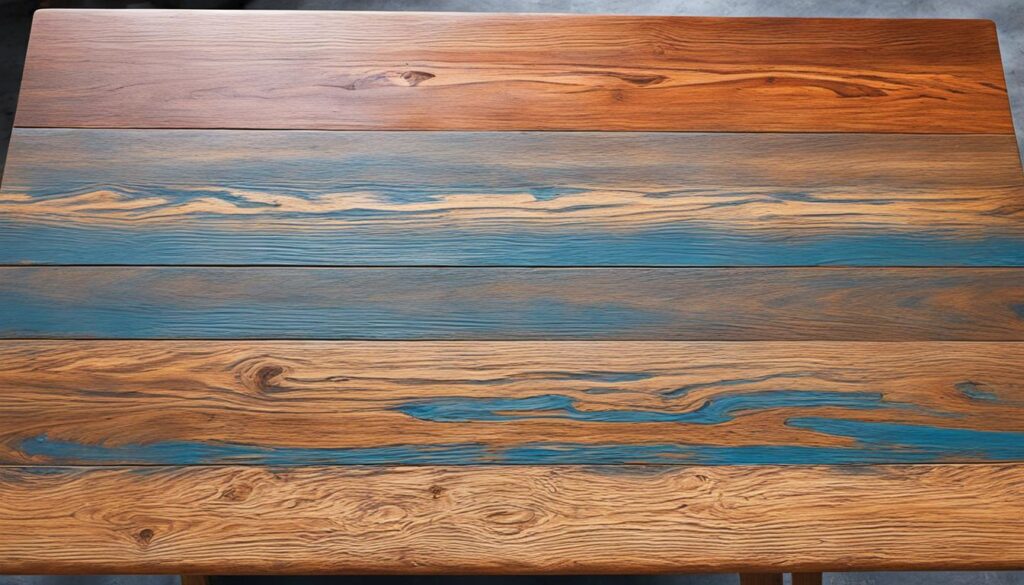Combining Danish oil with tung oil can enhance both durability and aesthetic appeal of wood finishes. Danish oil, a blend containing varnish, dries faster and provides a satin to semi-gloss finish. Tung oil, natural and labor-intensive, offers a matte sheen. However, Danish oil’s varnish component can impede tung oil’s curing process. When mixing, balanced proportions are essential to avoid compatibility issues. DIY blends often use equal parts oil, varnish, and solvent. Thorough application and curing are vital for effective results. Understand wood characteristics to harness the full potential of the mixture and achieve utmost wood care and protection.
Understanding Danish Oil and Tung Oil Finishes
Understanding the distinct properties and applications of Danish oil and tung oil is crucial for selecting the appropriate finish for woodworking projects.
Danish oil is a versatile oil blend, typically composed of tung oil, linseed oil, or both, combined with varnish. This composition allows Danish oil to provide a hard-wearing, water-resistant satin or semi-gloss finish, making it ideal for furniture care and wood protection. The varnish component in Danish oil guarantees a faster drying time of 4-6 hours per coat and fewer coats to achieve a durable finish.
In contrast, tung oil is a 100% natural oil derived from the seeds of the tung tree, originating from southern China. Known for its historical use in waterproofing ships, tung oil is valued for its ability to impart a natural, matte finish. However, pure tung oil requires a more labor-intensive application, needing 5-7 coats with drying times of 24-48 hours between each.
When considering oil wood finishes, the choice between Danish oil and tung oil hinges on the desired aesthetic and level of protection. Danish oil, with its varnish content, offers superior wood sealing techniques and ease of application.
Conversely, tung oil provides a more natural, food-safe finish, suitable for items like cutting boards.
Can You Mix Danish Oil With Tung Oil
Mixing Danish oil with tung oil is generally not advisable due to the varnish component in Danish oil, which can impede the proper adhesion and curing of pure tung oil. Danish oil is a blend that often includes tung oil, linseed oil, varnish, and solvents. This formulation provides a satin or semi-gloss finish, but the presence of varnish complicates the compatibility with pure tung oil.
Here are three key points to keep in mind:
Critical: The varnish in Danish oil can hinder the curing process of tung oil, leading to uneven finishes and potential durability issues.
Redundancy: Danish oil already contains drying oils like tung oil or linseed oil. Adding more pure tung oil may not enhance the wood finishing properties to a large extent.
DIY Blends: For those interested in combining wood oils, a common DIY approach is to create custom oil blends. A typical recipe includes one part tung oil or linseed oil, one part varnish, and one part mineral spirits. This combination mimics the properties of commercial Danish oil without the compatibility issues.
For wood finishing and furniture refinishing projects, understanding the specific characteristics of each oil finish is important. Combining wood oils without taking into account their chemical interactions can lead to suboptimal results in your DIY projects.
Applying Danish Oil and Tung Oil Mixtures
When applying Danish oil and tung oil mixtures, it is important to take into account their respective components and drying properties to achieve the best adhesion and finish quality. Danish oil, consisting of a blend of varnish and oils like tung or linseed oil, dries relatively quickly, typically within 4-6 hours per coat.
In contrast, pure tung oil, renowned for its natural wood oils and matte finish, can take 24-48 hours to dry.
Blending Danish oil and tung oil requires a nuanced understanding of their properties. Danish oil application is generally easier, providing a satin to semi-gloss finish with fewer coats, thanks to its varnish component. Conversely, tung oil properties yield a more natural, matte appearance, preferred for a more rustic look.
When mixing woodworking finishes for DIY wood oil blends, make sure that the proportions are balanced—typically one part tung oil, one part varnish, and one part thinner. This process creates effective wood finish blends that combine the durability of varnish with the natural beauty of tung oil.
For oil-based wood treatments, these mixtures must be applied uniformly, ensuring each layer dries thoroughly before applying the next to avoid adhesion issues and ensure excellent protection and aesthetics.
Mixing Your Own Danish Oil and Tung Oil Blend
Creating a custom Danish oil blend involves a meticulous balance of tung oil, varnish, and solvent to achieve the desired finish and durability. When mixing Danish oil and tung oil, it is important to understand the properties of each component.
Danish oil typically includes a blend of oils, such as tung oil or linseed oil, combined with varnish, which provides a satin or semi-gloss finish. Tung oil, on the other hand, is a pure oil that offers a more natural, matte finish.
To create a homemade wood oil mix, follow this common DIY recipe:
- One part tung oil or boiled linseed oil: This provides the essential oil properties and helps penetrate the wood.
- One part varnish (polyurethane or spar varnish): This adds durability and a protective layer to the finish.
- One part solvent (mineral spirits or naphtha): This thins the mixture, ensuring a smoother application and quicker drying time.
Adjusting the ratio of oil to varnish will influence the final sheen—more oil results in a matte finish, while more varnish results in a glossier appearance.
When considering oil wood stains and finishes compatibility, remember that combining Danish oil and tung oil in the right proportions can yield a versatile and durable wood finish suitable for various DIY wood finishing projects.
Advantages of Homemade Danish Oil and Tung Oil Mixes
Crafting a homemade Danish oil and tung oil blend offers essential control over the finish’s composition, allowing for precise adjustments in oil, varnish, and solvent ratios to tailor the final appearance and durability to specific project requirements. This customization guarantees top-notch results in wood finishing oils, particularly for diy wood projects and furniture restoration. Adjusting the proportions of tung oil and varnish can create a spectrum of wood oil finishes, from matte to semi-gloss, enhancing both aesthetic and functional attributes.
The ability to mix oils according to specific needs is vital for achieving safe oil combinations tailored for various types of wood and applications. For instance, increasing the tung oil content can improve water resistance and food safety, making it ideal for kitchenware and utensils in home improvement projects. Additionally, adding more solvent can make the mixture easier to apply, ensuring a smooth, even finish.
Moreover, controlling the drying oils and their ratios in your blend allows for more effective drying times, critical for timely project completion. Homemade oil finishes for wood can often be more cost-effective than commercial products while offering superior performance and customization for woodworking enthusiasts.
Potential Drawbacks and Considerations
Evaluating the potential drawbacks and considerations of using Danish oil, tung oil, or walnut oil is essential for ensuring the best finish and longevity of wood projects. Each oil has unique properties that can impact the final outcome of your woodworking techniques and wood protection methods.
Danish Oil Drawbacks: Danish oil, being a blend of oils and varnish, may leave an amber tint on lighter woods over time and is less ideal for food-safe applications. The varnish component makes it harder to repair or refresh compared to pure oil finishes.
Tung Oil Drawbacks: Pure tung oil requires a considerably longer drying time (24-48 hours between coats) and multiple thin coats (5-7 or more) to achieve an adequate protective finish. This can result in a more matte look, which might not be desirable for all wood finishes.
Walnut Oil Drawbacks: While walnut oil is highly food-safe, it offers minimal protection as a wood finish and can go rancid if not processed correctly. Its lack of moisture resistance and protection from stains or spills makes it less suitable for high-use items.
When considering oil mixtures or hybrid wood finishes, understanding these limitations will help you make informed decisions in your diy woodworking projects. Proper surface preparation remains critical for the efficacy of any wood care regimen.
Maintaining and Caring for Danish Oil and Tung Oil Finishes
Ensuring the longevity and aesthetic appeal of wood surfaces finished with Danish oil or tung oil necessitates a meticulous and regular maintenance routine. Proper wood maintenance is essential to preserving the integrity and beauty of your wooden furniture care.
Danish oil, a blend of oils and varnish, offers superior wood protection. It should be reapplied every 6-12 months. Clean the surface thoroughly, lightly sand with 320-400 grit sandpaper, and apply a thin, even coat. Remove excess oil after 10-15 minutes and allow 24-48 hours for curing.
Pure tung oil, favored for its natural matte finish, demands more frequent applications, typically every 3-6 months. Clean and dry the wood surface, then apply a thin coat, letting it penetrate for 30 minutes before wiping off excess. Multiple coats may be necessary, with at least 24 hours between each. Full curing takes several weeks.
| Maintenance Aspect | Danish Oil | Tung Oil |
|---|---|---|
| Reapplication Frequency | Every 6-12 months | Every 3-6 months |
| Sanding Requirement | Light sanding with 320-400 grit | Not usually required |
| Excess Oil Removal Time | 10-15 minutes | 30 minutes |
| Curing Time | 24-48 hours | Several weeks |
Avoid harsh cleaners and use placemats and coasters to prevent damage. Regular, light oil applications will ensure your wood finishes remain durable and visually appealing.
Welcome to WoodCraftYard.com, your one-stop destination for all things woodworking! I’m Oliver Candler, a dedicated woodworking aficionado and the creative mind behind this virtual woodworking haven. With a deep-rooted love for craftsmanship and a keen eye for detail, I am on a mission to share my passion for woodworking with fellow enthusiasts like yourself.
As a seasoned woodworker, I am committed to providing you with valuable insights, practical tips, and inspiring project ideas to help you unleash your creativity and master the art of woodworking. Whether you’re a seasoned pro or just starting out on your woodworking journey, join me as we carve, sand, and saw our way through the world of woodworking together.
Let’s embark on this woodworking adventure, where every knot, grain, and finish tells a unique story. Together, let’s craft, create, and build something truly extraordinary at WoodCraftYard.com!




